- Comfrey and Compost Piles
I can’t remember how comfrey (Symphytum officinale L.) got introduced into my garden, but it probably came from Geoff when he worked at Nokomis Gardens in East Troy, Wisconsin, about sixteen years ago. It’s now firmly established just north of the garden beds and west of the compost area. The plants are gradually expanding their area of control and comfrey can become a pest with its ability to spread, but I’m welcoming what I currently have and I won’t worry about it taking over just yet.
I took advantage of a drizzly Saturday morning to turn over a compost pile without having to drag hoses or carry in water to get the compost slightly damp. I thought that layering in a lot of comfrey leaves would bring in some more moisture while adding beneficial nutrients of the leaves to the pile.
The pile I turned had been sitting for a year. I usually have three piles going simultaneously. The current year’s pile on the right of the picture is everything I’ve pulled out of the garden this year, mainly weeds and crop residue. The pile from a year ago was turned once and mixed with a 55 gallon drum of household compost. That’s the one I’m working on. And the remainder of a two year old pile is being stored and kept dry in two garbage cans. It has been screened and is ready for use yet this year or next spring.
The benefits of comfrey as a compost plant are well documented. Its deep tap roots bring up an exceptional array of nutrients and make comfrey leaves a rich source of nitrogen, potassium, calcium and a whole shopping list of vitamins and minerals. Organic gardeners and permaculture disciples consider it a most perfect plant.
Comfrey’s huge leaves can be harvested up to four times a year merely buy slicing them off at ground level. I use a little Japanese hand axe called a kama, pictured above, and it’s quite easy to chop the soft stems.
- Layering in Comfrey Leaves
Another benefit of this remarkable plant is that the leaves break down quickly whether in a compost pile or when used as a mulch. Here is the pile being layered with comfrey. Compost purists will argue that compost piles have to be built just right and that they must be brought to a specific temperature to kill weed seeds, but I don’t worry about the technical details. My gardening technique allows for lots of weeds, which I keep in control with shallow cultivation. So if the piles don’t reach a specific temperature, I really don’t care.
- Finished Compost Pile
Here’s the finished pile. Next spring it will be ready to screen and put back into the garden. You can’t have too much compost so I make a lot. Working it back into the garden has made my beds softer, more manageable, and of course, more fertile.

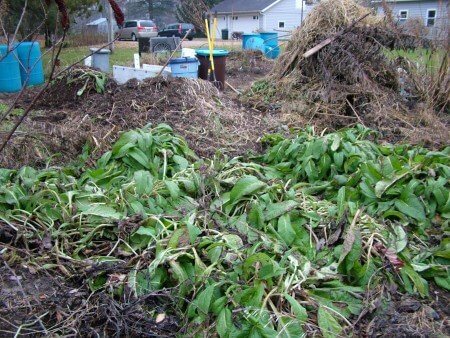
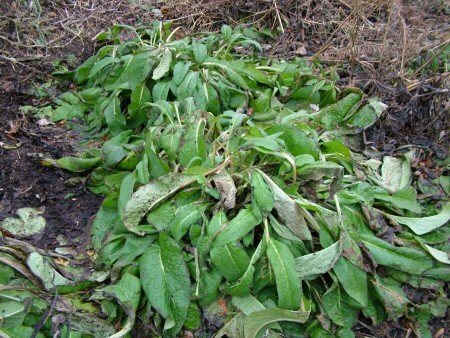
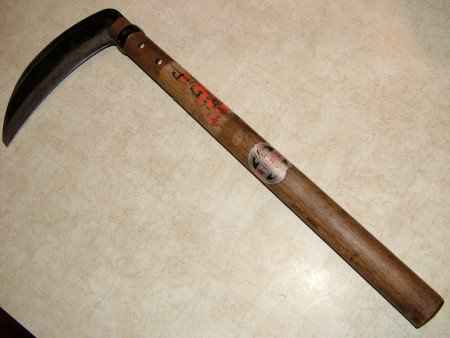
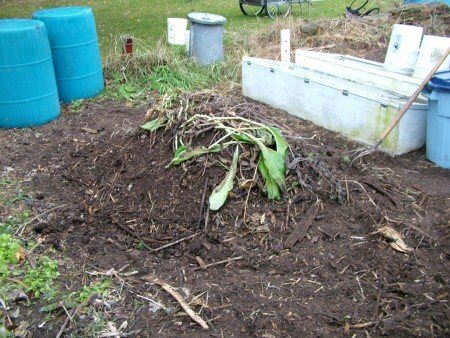
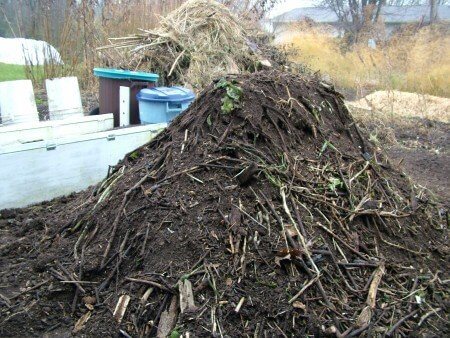
Hi, I saw a gardening video were the man opted for a worm bin over
a compost pile. He had a large galvanized feedinng trough and slightly
elevated on one end and a few holes drilled in the other to collect the liquid.
What are your thoughts on the pros and cons of each?
I have to tell you how wonderful the Cobrahead tools are too.
Great for keeping up with the dandylions without using spays.
Bee friendly!
Worm compost is great stuff, and I don’t think it’s an either or decision. I have the space to do large compost piles outside so the method I use is easy for me. Compost piles are usually easier maintenance than setting up a worm composting system. Worm compost is richer in nutrients than simple compost, but I have a very adequate supply and I have plenty of worms working my pile, so I’ve opted to go the easier route.